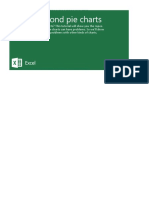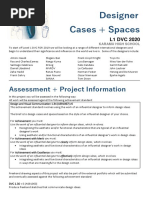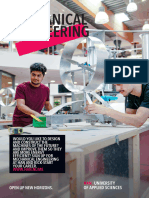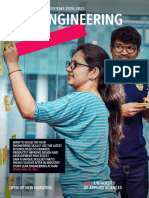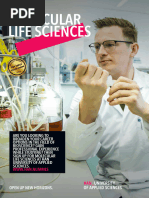0 ratings0% found this document useful (0 votes)
28 viewsPortfolio Guidance Art & Design
Portfolio Guidance Art & Design
Uploaded by
Alexandra ErhanThe document provides guidance for applicants on preparing an online portfolio for art and design programs, including recommending 6 complete projects that demonstrate skill, interest, and ideas. It suggests including process like research, development, and experimentation for some projects to show how applicants think and work through ideas.
Copyright:
© All Rights Reserved
Available Formats
Download as PDF, TXT or read online from Scribd
Portfolio Guidance Art & Design
Portfolio Guidance Art & Design
Uploaded by
Alexandra Erhan0 ratings0% found this document useful (0 votes)
28 views82 pagesThe document provides guidance for applicants on preparing an online portfolio for art and design programs, including recommending 6 complete projects that demonstrate skill, interest, and ideas. It suggests including process like research, development, and experimentation for some projects to show how applicants think and work through ideas.
Original Title
175
Copyright
© © All Rights Reserved
Available Formats
PDF, TXT or read online from Scribd
Share this document
Did you find this document useful?
Is this content inappropriate?
The document provides guidance for applicants on preparing an online portfolio for art and design programs, including recommending 6 complete projects that demonstrate skill, interest, and ideas. It suggests including process like research, development, and experimentation for some projects to show how applicants think and work through ideas.
Copyright:
© All Rights Reserved
Available Formats
Download as PDF, TXT or read online from Scribd
Download as pdf or txt
0 ratings0% found this document useful (0 votes)
28 views82 pagesPortfolio Guidance Art & Design
Portfolio Guidance Art & Design
Uploaded by
Alexandra ErhanThe document provides guidance for applicants on preparing an online portfolio for art and design programs, including recommending 6 complete projects that demonstrate skill, interest, and ideas. It suggests including process like research, development, and experimentation for some projects to show how applicants think and work through ideas.
Copyright:
© All Rights Reserved
Available Formats
Download as PDF, TXT or read online from Scribd
Download as pdf or txt
You are on page 1of 82
Portfolio Guidance
Art & Design
A guide on
preparing
your online
portfolio.
At Coventry University,
we would like to see…
6 Complete Projects
(or 20 images)
The selected projects should show
your interest, skill and idea generation.
6 Complete Projects
(or 20 images)
You should carefully select your
projects. More is not always more.
6 Complete Projects
(or 20 images)
You should always start and end
with your best, most cherished
projects.
6 Complete Projects
(or 20 images)
Projects must be a balance of:
• Self-Initiated projects (things you did for
yourself that show passion, curiosity and a
particular interest or goal)
• School Projects (that respond to a brief or
task and demonstrate your ability to work
with limitations and constrains)
6 Complete Projects
(or 20 images)
Projects must be a balance of:
• Self-Initiated projects (things you did for
yourself that show passion, curiosity and a
particular interest or goal)
• School Projects (that respond to a brief or
task and demonstrate your ability to work
with limitations and constrains)
6 Complete Projects
(or 20 images)
We are keen on process, well as final
outcomes. It shows us the way you think and
your potential. Therefore, consider including
more background information for at least 3 of
your projects:
• Research
• Development
Research—shows us you’re curious and want
to learn. It includes things from your
sketchbook like:
Observational drawings
Articles and books
Visual references
Development and Experimentation—shows
us how you work through your ideas:
Sketches
Experimenting with different media
(paint, ink, graphite, paper, etc.)
Idea generation
Architecture &
Interior Design
Space, scale and perspective
Drawing in a wide variety of media,
pencil, paint, ink, pen
Expressive and technical drawings
of exterior and interior of spaces
showing spatial understanding
Draw architectural details
Draw from different perspectives,
birds eye and worms eye views!
Model making/3-D experience of
any sort demonstrating scale and
volume, these can be very simple
in construction, be playful and
innovative!
Work must be photographed well!
Automotive &
Transport Design
Drawing: Observational, technical,
exploratory, expressive, communicative,
diagrammatic
Observational transport/car drawings
from life (not tracings), these should
demonstrate strong evidence of
perspective, scale.
Look to draw the interior and details of
actual transport spaces (not
photographs).
Strong product design and architectural
projects will demonstrate skills in scale,
volume and perspective.
Ensure drawings aren’t just in pencil
and pen, a broad range of media is
important. Pens, ink, wax, graphite.
Model making/3-D experience of any
sort, well photographed.
Examples of prototypes, sculpture,
foam/card, engineering projects will
show a understanding of material use
and 2-D to 3-D understanding
Product Design
Creative problem solving and context is key
Identifying a service or product that could
be improved in interesting ways
Drawing: observational, technical,
exploratory, expressive, communicative,
diagrammatic
Demonstrate spatial awareness and
understanding (perspective and proportion)
Model making/3-D experience of any sort—
well photographed! Examples of prototypes,
sculpture, ceramics, engineering projects
will show a understanding of material use
Evidence knowledge of contemporary
designers that inspired you to become a
Product Designer.
Journaling/visually recording your making
and production skills
Fashion
Strong sense of individual/
primary research and
development (drawing,
collage, photography and
colour awareness)
Evidence fabric manipulation
and textile experimentations.
Life drawing or observational
fashion illustrations to show
you can understand
designing for the body.
Show us concept/
moodboards summarising
your projects.
Fine Art
Idea and concept generation is
crucial.
How you ‘think’ in your portfolio,
your particular talent and
specialism should be supported
with journaling of your thought
process and analysis of creative
decisions.
Show us your drawing, painting,
sculpture/installation or other 3D
work, photographs, prints, video,
sound and digital media.
We are always interested to see
and hear about a broad spectrum
of your creative activities so bring
evidence of other forms you have
worked in such as performance,
music/audio, writing, textiles,
design etc.
Illustration &
Games Art
storytelling and narrative are key.
All story telling happens in spaces
and places so drawings
evidencing characters in context
is desirable.
A broad variety of drawing styles
and media is important to
evidence. Pen, pencil, collage,
acrylics, cutwork, oil pastel and
felt-tip, charcoal and wax.
Life drawing and figurative
drawing is great as it shows us
observational skills in proportion
and perspective.
Story boarding (thumbnail
sketches) is a great way to show
us your ideas and what story your
illustrations are telling.
Original drawings not tracings!
Graphic Design
Standalone work (posters, music covers)
Campaign oriented (series of connecting
elements i.e.poster + flyer)
Editorial (layout) and sequencing (a few
spreads)
Playful integration of text (fonts) and
image (photography, collage, drawing,
illustration)
Technical skills (some digital skills i.e.
Photoshop and drawing, photography)
An understanding of your design in
context (some knowledge of existing
design scene and ability to articulate
why certain designs work).
Concept and ideas.
Research (how you reached those ideas)
and development (how you worked with
the ideas)
10:50 AM 15°24’15”N, 30°E10’3” 10:50 AM 15°24’15”N, 30°E10’3”
6 Complete Projects
(or 20 images)
You should consider the presentation of
your portfolio. It shows us you have a
good awareness of industry standards.
Demonstrate visual literacy through
interesting layouts and consistency.
Aim for:
• Clean
• Clear
• Structured
• Works well photographed or scanned
• No pixelation
• Landscape (if online)
• Save as .pdf
Don’t forget your
Personal Statement!
Tell us about your passion,
interest and inspiration in
your chosen course and
design area. Tell us about
your professional and
personal abilities that will
support your application.
Make it dynamic!
Thank you!
Questions?
http://blogs.coventry.ac.uk/artanddesign/
Insta: @Coventryfah_
Twitter: @coventryfah
Facebook: Coventry University
Faculty of Arts and Humanities
You might also like
- Bio Cluj 2024Document222 pagesBio Cluj 2024Alexandra Erhan100% (1)
- Igcse Art Coursework ChecklistDocument7 pagesIgcse Art Coursework Checklistdgmtutlfg100% (1)
- Arabic Geometrical Pattern and DesignDocument228 pagesArabic Geometrical Pattern and Designadaveco100% (20)
- Beyond Pie Charts Tutorial Dari ExcelDocument82 pagesBeyond Pie Charts Tutorial Dari ExcelSakarepkNo ratings yet
- SVE Event GuideDocument22 pagesSVE Event GuideMadalina MarinacheNo ratings yet
- Portfolio Graphic Design Illustration 20121217Document6 pagesPortfolio Graphic Design Illustration 20121217Laura MariaNo ratings yet
- Portfolio Interior Design 20121023 LandscapeDocument7 pagesPortfolio Interior Design 20121023 LandscapeConstantinescu PetruNo ratings yet
- The Secrets of Fashion Drawing: An insider's guide to perfecting your creative skillsFrom EverandThe Secrets of Fashion Drawing: An insider's guide to perfecting your creative skillsRating: 5 out of 5 stars5/5 (1)
- Artist Resume ExampleDocument5 pagesArtist Resume Examplemtywrhajd100% (1)
- Portifolio Making ProcessDocument15 pagesPortifolio Making Processsaran rajNo ratings yet
- ART412Document9 pagesART412s.mikjikjNo ratings yet
- Architectural Thesis Presentation LayoutDocument8 pagesArchitectural Thesis Presentation Layoutkcaevuief100% (1)
- 2313 Graphic Design TAMUK FALL 2020 The Creative Process PDFDocument1 page2313 Graphic Design TAMUK FALL 2020 The Creative Process PDFJesus De La RosaNo ratings yet
- Design Application GuidanceDocument18 pagesDesign Application GuidanceCastcastNo ratings yet
- Art and Design Coursework Training HandbookDocument4 pagesArt and Design Coursework Training Handbookbcrqy80d100% (2)
- Graphic Designing NotesDocument22 pagesGraphic Designing NotesPeter NdoroNo ratings yet
- 2020 Designer Cases and SpacesDocument4 pages2020 Designer Cases and Spacesapi-250883541No ratings yet
- Character Design Crash CourseDocument1,369 pagesCharacter Design Crash Coursencco rccs100% (1)
- PortfolioDocument1 pagePortfoliodosmakhanuNo ratings yet
- SEGD World TourDocument50 pagesSEGD World ToursamuelaireNo ratings yet
- Assignment 2 GuidelinesDocument2 pagesAssignment 2 Guidelinestalhamazari100No ratings yet
- Deep Diveinto ArtsDocument7 pagesDeep Diveinto Artsashwini.m.babarNo ratings yet
- Overview of AP Art and Design - FiveableDocument3 pagesOverview of AP Art and Design - FiveableCloud FangNo ratings yet
- Igcse SketchbooktipsDocument12 pagesIgcse Sketchbooktipsapi-223541325No ratings yet
- ART 4958 Thesis Overview 2020Document8 pagesART 4958 Thesis Overview 2020Via AnapiNo ratings yet
- 2-Graphic Design CareersDocument12 pages2-Graphic Design CareersQuang Hậu LêNo ratings yet
- TEC 214 Module 1 Lesson 1Document31 pagesTEC 214 Module 1 Lesson 1Kim So-Hyun100% (2)
- Portfolio Fashion Design Landscape 2Document7 pagesPortfolio Fashion Design Landscape 2Meher KalwaniNo ratings yet
- Simerge'24 (1) 3Document2 pagesSimerge'24 (1) 3Muhammad AwaisNo ratings yet
- 7B54F91C-9455-4BD1-A4CB-D56887F255A1-removebg-previewDocument8 pages7B54F91C-9455-4BD1-A4CB-D56887F255A1-removebg-previewjulia.p.valente5No ratings yet
- Drawing & Renderng I (1)Document99 pagesDrawing & Renderng I (1)pwembledonNo ratings yet
- PORTFOLIO - GUIDELINES - EN - 2023 - 2024.docx (1) .653b8f4ce2b660.35173570Document14 pagesPORTFOLIO - GUIDELINES - EN - 2023 - 2024.docx (1) .653b8f4ce2b660.35173570deepthinayak366No ratings yet
- Graphic Design AssignmentsDocument5 pagesGraphic Design Assignmentsafodcjfwmxseea50% (2)
- Sketching Seminar With Dave Malouf - June 2009Document3 pagesSketching Seminar With Dave Malouf - June 2009Abe Crystal100% (2)
- Module 1 Graphic DesignerDocument26 pagesModule 1 Graphic DesignerchandanNo ratings yet
- Visual Creativity A PDFDocument73 pagesVisual Creativity A PDFanandanickNo ratings yet
- Visual Art Classes PPDocument15 pagesVisual Art Classes PP44864No ratings yet
- Fa Application Guideines 15 16Document95 pagesFa Application Guideines 15 16Buffalo JimmyNo ratings yet
- Tips To Teach Yourself Graphic DesignDocument25 pagesTips To Teach Yourself Graphic DesignVich Andrei Cortez100% (5)
- ba_portfolio-guidelinesDocument3 pagesba_portfolio-guidelinesmarkeddisson15No ratings yet
- Positive Force: Design As ADocument4 pagesPositive Force: Design As ASelim RezaNo ratings yet
- Architectural Thesis Presentation BoardsDocument8 pagesArchitectural Thesis Presentation Boardsafknqbqwf100% (2)
- Thesis Graphic DesignDocument5 pagesThesis Graphic Designannmontgomeryjackson100% (2)
- Process Portfolio Information For StudentsDocument4 pagesProcess Portfolio Information For Studentsapi-263421806No ratings yet
- 11-Graphic and Plastic ArtDocument72 pages11-Graphic and Plastic ArtAngeline CuriosoNo ratings yet
- Design School BDocument4 pagesDesign School Brthi kusumNo ratings yet
- The Way in - (A Designer's Career Guide) - 2010Document18 pagesThe Way in - (A Designer's Career Guide) - 2010guijarroj100% (1)
- Final Major Project Statement of IntentDocument9 pagesFinal Major Project Statement of IntentPolly WilliamsNo ratings yet
- Public Art Course Outline 2014 2015Document6 pagesPublic Art Course Outline 2014 2015api-245646007No ratings yet
- Art and DesignDocument20 pagesArt and DesignMishealNo ratings yet
- Drawing Assessment CriteriaDocument1 pageDrawing Assessment Criteriaapi-254314751No ratings yet
- Fine Art Guidelines 1Document2 pagesFine Art Guidelines 1annaNo ratings yet
- From Pixels To Masterpieces A Guide To Digital ArtistryDocument2 pagesFrom Pixels To Masterpieces A Guide To Digital Artistryqosiqosi7No ratings yet
- Architecture Design Studio 1 Project 1 Brief March 2016Document4 pagesArchitecture Design Studio 1 Project 1 Brief March 2016api-289017690No ratings yet
- New Text DocumentDocument2 pagesNew Text DocumentShilpaNo ratings yet
- Sculptor Faith FaithDocument13 pagesSculptor Faith FaithdonellafaithNo ratings yet
- Udr 2017Document12 pagesUdr 2017Aarthi ChandrasekharNo ratings yet
- gka vers graphics design curriculumDocument3 pagesgka vers graphics design curriculumtonyadmiral220No ratings yet
- Assessment Schedule l3Document3 pagesAssessment Schedule l3api-203589588No ratings yet
- How To Make An Architectural PortfolioDocument16 pagesHow To Make An Architectural PortfolioJahangeer KhanNo ratings yet
- FAS7039 Pre-Break Briefing 2023Document15 pagesFAS7039 Pre-Break Briefing 2023NV TrilochanNo ratings yet
- Art Vs Design (Expository Text)Document3 pagesArt Vs Design (Expository Text)yellybarlianNo ratings yet
- Foundation Project Proposal 1Document10 pagesFoundation Project Proposal 1api-725346333No ratings yet
- Bachelor of Science in Engineering/ Bachelor of Engineering Master of Science in EngineeringDocument12 pagesBachelor of Science in Engineering/ Bachelor of Engineering Master of Science in EngineeringAlexandra ErhanNo ratings yet
- Atlas Medclass - Barron'sDocument96 pagesAtlas Medclass - Barron'sAlexandra Erhan100% (1)
- Discover Excel Lence!: West UniversityDocument24 pagesDiscover Excel Lence!: West UniversityAlexandra ErhanNo ratings yet
- 1585143277ba Mechanical EngineeringDocument4 pages1585143277ba Mechanical EngineeringAlexandra ErhanNo ratings yet
- Undergradua1Ie Prospecmus: University of GreenwichDocument116 pagesUndergradua1Ie Prospecmus: University of GreenwichAlexandra ErhanNo ratings yet
- HealthDocument20 pagesHealthAlexandra ErhanNo ratings yet
- 1585143219ba Electrical and Electronic EngineeringDocument4 pages1585143219ba Electrical and Electronic EngineeringAlexandra ErhanNo ratings yet
- 1585572714sport Health and Exercise Sciences Course Brochure Ug PG b5 24pp Dps - 9333 Ac v4 Final 150dpi - 3110Document13 pages1585572714sport Health and Exercise Sciences Course Brochure Ug PG b5 24pp Dps - 9333 Ac v4 Final 150dpi - 3110Alexandra ErhanNo ratings yet
- 1585143448mes Lean EngineeringDocument4 pages1585143448mes Lean EngineeringAlexandra ErhanNo ratings yet
- 1585143334ba Life SciencesDocument4 pages1585143334ba Life SciencesAlexandra ErhanNo ratings yet
- 1585221765falmouth University Undergraduate Prospectus 2021Document188 pages1585221765falmouth University Undergraduate Prospectus 2021Alexandra ErhanNo ratings yet
- 1585234894iuf Presentation Avans UasDocument48 pages1585234894iuf Presentation Avans UasAlexandra ErhanNo ratings yet
- 1585149105international Students GuideDocument8 pages1585149105international Students GuideAlexandra ErhanNo ratings yet
- 1585151310maeis Trilingual Studies European Policy and GovernanceDocument8 pages1585151310maeis Trilingual Studies European Policy and GovernanceAlexandra ErhanNo ratings yet
- WWW - Edmerica.ro: Benefits and Unique FeaturesDocument2 pagesWWW - Edmerica.ro: Benefits and Unique FeaturesAlexandra ErhanNo ratings yet
- 1585143553studying in The NetherlandsDocument2 pages1585143553studying in The NetherlandsAlexandra ErhanNo ratings yet
- 1585143465mes Sustainable EnergyDocument4 pages1585143465mes Sustainable EnergyAlexandra ErhanNo ratings yet
- 1585149088international ProspectusDocument56 pages1585149088international ProspectusAlexandra ErhanNo ratings yet
- Ma Molecular Life SciencesDocument4 pagesMa Molecular Life SciencesAlexandra ErhanNo ratings yet
- Topographic MapsDocument21 pagesTopographic MapsJameel JameelNo ratings yet
- Wieliczka - Herb - Coat of Arms - Crest of WieliczkaDocument3 pagesWieliczka - Herb - Coat of Arms - Crest of WieliczkaLouisaMjjNo ratings yet
- Sarana Pengelolaan LimbahDocument14 pagesSarana Pengelolaan LimbahBroks LeeNo ratings yet
- NP234 (A) 20Document70 pagesNP234 (A) 20MiguelNo ratings yet
- 100 Picture Books PDFDocument1 page100 Picture Books PDFjuliaviabeNo ratings yet
- Bloomsburydesign Uk Cropped LRDocument48 pagesBloomsburydesign Uk Cropped LRMarcelo Hernandez BorbaNo ratings yet
- Examples of Graphic ArtsDocument11 pagesExamples of Graphic ArtsRovel John BriñosaNo ratings yet
- 4.data InterpretationDocument47 pages4.data InterpretationNAVA BHARATHINo ratings yet
- Download full Illustration A Theoretical and Contextual Perspective Alan Male ebook all chaptersDocument71 pagesDownload full Illustration A Theoretical and Contextual Perspective Alan Male ebook all chaptersmightglikoui100% (3)
- Circuit Hitachi - EliteDocument68 pagesCircuit Hitachi - EliteJaxon Mosfet80% (5)
- Smart App PowerPoint Template by SlideWinDocument29 pagesSmart App PowerPoint Template by SlideWindiantoro rudNo ratings yet
- ICT 18 An IllustratorDocument1 pageICT 18 An Illustratorzamirbekkyzy2003No ratings yet
- Engineering DrawingDocument26 pagesEngineering DrawingChristian Makande100% (1)
- Chapter 13Document29 pagesChapter 13Piyush SethNo ratings yet
- Assignment 4 IsometricDocument2 pagesAssignment 4 IsometricJamaliah AhmadNo ratings yet
- Peningkatan Produktivitas SDM PerusahaanDocument51 pagesPeningkatan Produktivitas SDM PerusahaanAlfonsus SasandoNo ratings yet
- 28 A. Station Auxiliary Board - Rev-01Document131 pages28 A. Station Auxiliary Board - Rev-01kha nguyenNo ratings yet
- S11 Excel Charts STARTDocument15 pagesS11 Excel Charts STARTgeraldNo ratings yet
- Children's Illustrators Exhibition AttachmentDocument22 pagesChildren's Illustrators Exhibition AttachmentJerry Farber100% (4)
- Eco-Friendly+Packagings+Presentation+Green+variantDocument26 pagesEco-Friendly+Packagings+Presentation+Green+variantChi KhánhNo ratings yet
- Crucify of JesusDocument55 pagesCrucify of JesusAloysius Tatus KristantoNo ratings yet
- Work Portfolio Meher SaraDocument88 pagesWork Portfolio Meher SaraMeher SaraNo ratings yet
- Tugas Jembatan Rangka Baja: UnderDocument48 pagesTugas Jembatan Rangka Baja: Undersvantike shopNo ratings yet
- Diagrama de CT-20 NuevaDocument76 pagesDiagrama de CT-20 NuevaErik ValenzuelaNo ratings yet
- Unit 3 - Design Development, Techpack & SamplesDocument8 pagesUnit 3 - Design Development, Techpack & Samplesmaya_muth100% (1)
- Plans and ElevationsDocument24 pagesPlans and ElevationsCarole ThamiNo ratings yet
- Portfolio InventoryDocument2 pagesPortfolio InventoryTan Ming KenNo ratings yet



